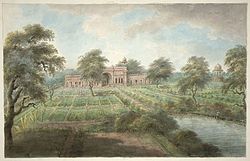- The Sheesh Mahal at Shalimar Bagh, Delhi.
- The Parterre and shade trees.
- The garden pavilion.
- The Badli Sarai were Caravanserai in the vicinity of Shalimar Bagh a kilometre away at Badli-ki-Serai.
- A tomb Maqbara-E-Paik (messenger's mausoleum) 2.5 kilometres away in the vicinity of Shalimar Bagh.
| Shalimar Bagh, Delhi | |
|---|---|
| Shalimar Garden or Aizzabad Bagh | |
 Shalimar Gardens, Delhi in 1814, showing the majestic Parterre and Diwan Khana (visitors pavilion) in the background. | |
 | |
| Type | Mughal garden |
| Location | Delhi, India |
| Coordinates | 28°43′14″N77°09′15″E / 28.72056°N 77.15417°E |
| Area | 6 hectares (15 acres) |
| Opened | 1653 |
| Founder | Izz-un-Nissa wife of Mughal emperor Shah Jahan |
| Owned by | Archaeological Survey of India |
| Operated by | Archaeological Survey of India |
Shalimar Bagh also known as Shalimar Garden is a Mughal garden located in Delhi, India. It was named as Aizzabad Bagh when the garden was laid by Izz-un-Nissa wife of Mughal emperor Shah Jahan in 1653 as a tribute and replica of Shalimar Bagh, Kashmir, laid by erstwhile Mughal emperor Jahangir in 1619, the Shalimar Bagh of Delhi is now abandoned but still houses shade trees, majestic parterre and structure such as the Sheesh Mahal and the garden pavilion.




